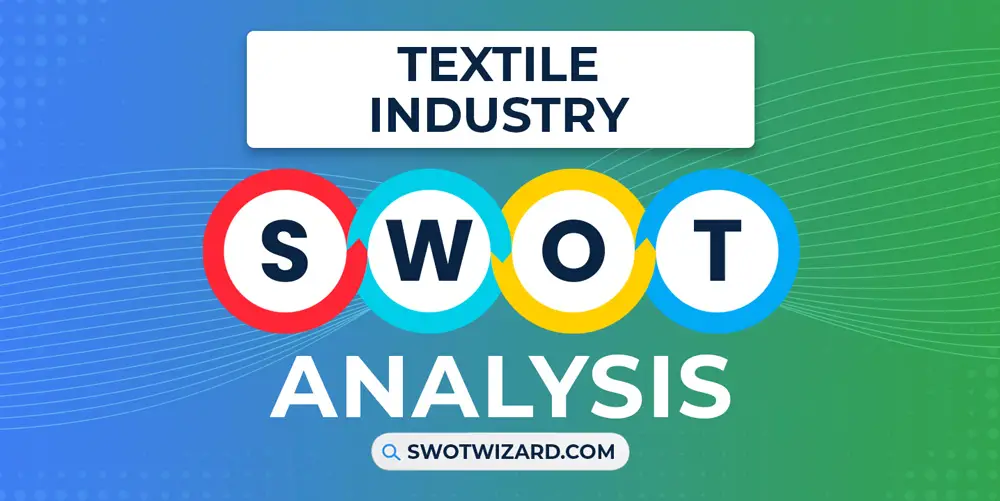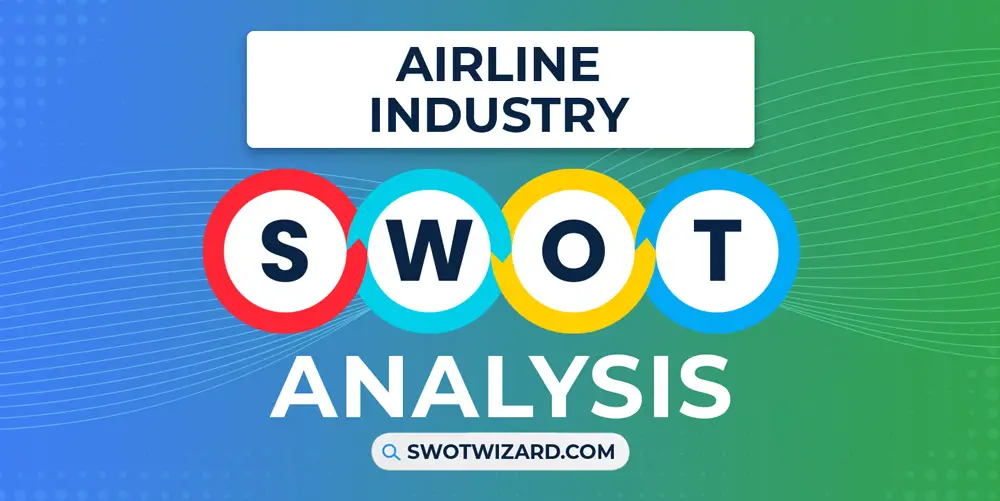From baby clothes to dying men wearing clothes are a regular part of our life. It reflects our personality, choices, expressing identity, status, style, and many untold things about human beings. It’s not the social and cultural contexts, but how people perceive by looking at and developing social interactions and relationships.
And, in that story, the textile industry makes millions of stories every day just by simply making what we are wearing. In the background, the industry has its story, ups and downs, with millions of workers, thousands of factories, and many more playing a significant role in shaping human culture and society, which we will get to know in this textile industry swot analysis.
Textile Industry Overview
The textile industry has a long history dating back to ancient civilizations, when cotton, silk, wool, and flax fibers were made through rigorous processes. But the modern industry can be traced back to the Industrial Revolution of the 18th century.
Today, the industry significantly contributes to global economic growth, with a revenue of $1,834 billion in 2022 and employing over 75 million workers worldwide in over twenty thousand factories. With a global growth rate of 6.6% in 2022, the industry has been experiencing steady growth.
But the industry is growing more robust than ever with constant innovation and evolution, focusing on adopting sustainable practices and leveraging new technologies to drive growth and profitability.
Competitors in Textile Industry
Arvind Limited | Ha-Meem Group | Ananta Group | Bombay Dyeing | Fabindia | Grasim Industries | Raymond Limited | Indo Phil | Jude Jade Textile
Did You Know?
If it took you one minute to reach this part of the article, it means there were 286,000 garments made by that time, 284,722 garments being sold, and 70% of all the clothes were second-hand.
Strengths – Textile Industry SWOT Analysis
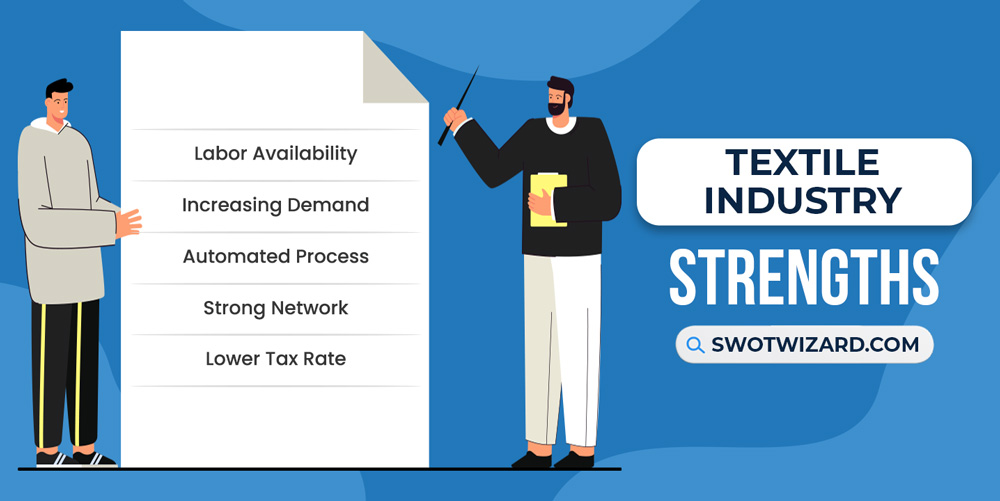
Labor Availability: One of the major or maybe the most fundamental reasons for the textile industry’s growth happened because of cheap and high labor availability. Many third-world countries, such as Bangladesh, Vietnam, and even first-world countries, such as China and Germany, have cheap labor sources at a meager cost.
Increasing Demand: Cloths are part of our everyday life, and whether it’s cheap $2 clothing or a luxury or fashion item, every demand is fulfilled and made by the textile industry. And the demand is increasing every year, expanding the market size, and likely to grow by at least 5% in 2023.
Automated Process: As the industry was starting to grow more than expected, they needed to develop new effective, efficient processes to help make it scalable. As a result, there are innovative software and machinery to help and positively impact the entire industry to make it grow more.
Strong Network: The link and communication among the textile industry stakeholders helped maintain a strong linkage among them and grow the industry. In the past few years, the companies helped each other recover from the pandemic by maintaining good relationships and getting the industry growth back on track.
Lower Tax Rate: Many third-world countries, whose primary or the big chunk of the export business relies on the textile industry, have lower corporate tax rates for the companies, both from host and guest countries. As a result, we can see that in the top garment exporters, Germany, Bangladesh, and other counties, the corporate textile tax rate is around 12 to 15%.
Weaknesses – Textile Industry SWOT Analysis
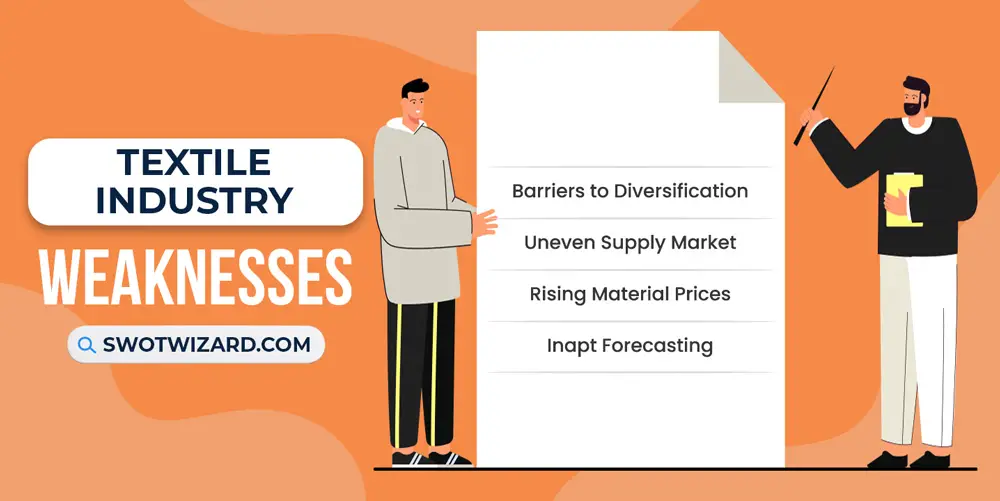
Barriers to Diversification: One of the most significant weaknesses the entire industry faces is that they can suddenly change anything, whether it’s machinery, other management systems, or anything when it’s already implied. Once something is in the system already, it takes years and becomes more expensive to change the system.
Uneven Supply Market: Most buyers in this market are specific companies, not to mention they are based on a few particular regions or continents. The EU and USA are the two largest importers of the entire industry, and the total import value stands at $119 B in 2022 alone, which makes the uneven supply market clear.
Rising Material Prices: Other prices apart, the primary materials in the internal sectors are continuously increasing, and in 2022 alone, there are a few sectors where prices multiplied by even sixty percent. And the stats show that the rising oil price will affect the prices in the textile industry again.
Inapt Forecasting: It is almost impossible to demand and supply curve on check with the market as the forecasting always seemed inaccurate. Whether it’s people and market demand or pandemic, weather, and other issues, the inapt forecasting by the industry is a big issue in tackling the proper demand and supply.
Opportunities – Textile Industry SWOT Analysis
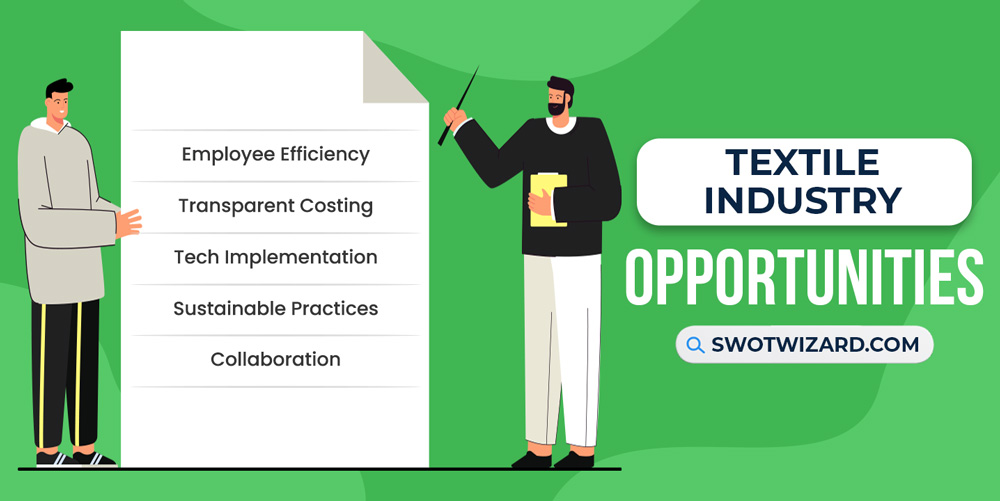
Employee Efficiency: It’s well known that the RMG workers are highly unskilled, hammering the overall effectiveness and efficiency. Industry leaders and governments can come together to offer better training programs for them, which will pay off in better work effectiveness and efficiency.
Transparent Costing: As the industry is growing, there are many issues related to supply demand and a term called “open costing facility,” which promises a better relationship between the stakeholders from both suppliers and buyers end, and there is less miscommunication and better efficiency.
Tech Implementation: With the world moving towards more tech and innovations, it has reached the textile industry too. But, there were always issues with compatibility and the lengthy process to implement the techs, which can be solved with modern and advanced tech in textiles that can make the process more efficient.
Sustainable Practices: The study shows that around 20% of wastewater is because of the textile industry, and as a result, industry leaders are moving toward more sustainable practices. That’s why there are now more green factories; even buyers are most interested in buying products from there.
Collaboration: There are many challenges that more or less every country’s textile industry is facing. And collaboration among the countries’ textile industry leaders and other stakeholders has been essential more than ever to solve those issues for the industry’s growth and better effectiveness in the work process.
Threats – Textile Industry SWOT Analysis
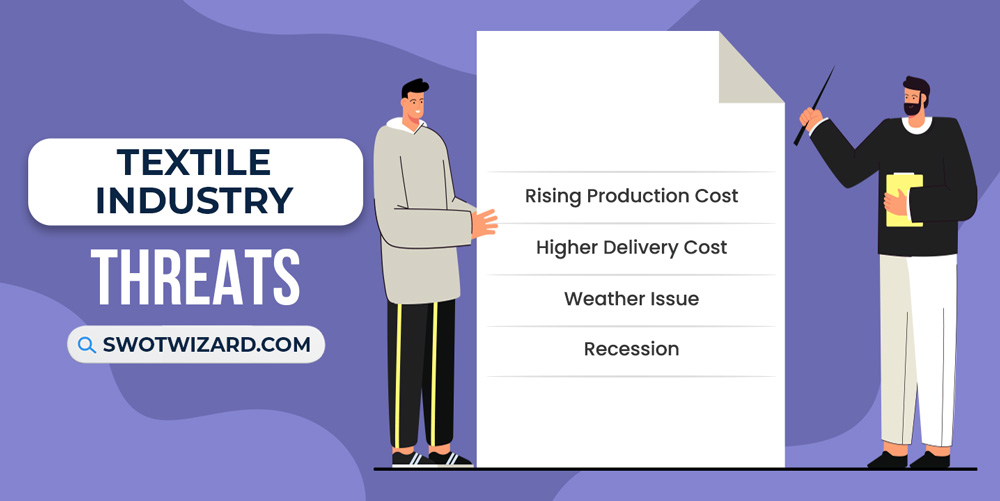
Rising Production Cost: 2022 was a year of rising costs in all sectors, hitting the textile industry pretty hard. The raw material prices have been increased from 10% to even 40% in some cases in India and other primary textile exporters. As a result, the overall prices related to textiles have increased.
Higher Delivery Cost: Oil and other fuel prices have been rising in the last couple of years, and since the Russia-Ukraine war, they have hit the roof. As a result, the delivery, freight cost, and every cost in the delivery process has increased a lot, which affected the buyers and sellers, both parties, and ultimately raised the price of the final products.
Weather Issue: The weather affects a lot in the textile industry and even the process of the garments, not to mention reaching the final products to the buyers. In contrast, the weather can affect the quality of the product and even delay the shipment due to bad weather and other issues.
Recession: The 2008 recession caused a significant decline in global textile production and consumption, with textile manufacturing experiencing layoffs and bankruptcies. As the 2023 recession might be a possibility, it will indeed affect once again, resulting in dropping sales, disruption in the supply chain, and many more issues.
[Bonus Infographic] SWOT Analysis of Textile Industry
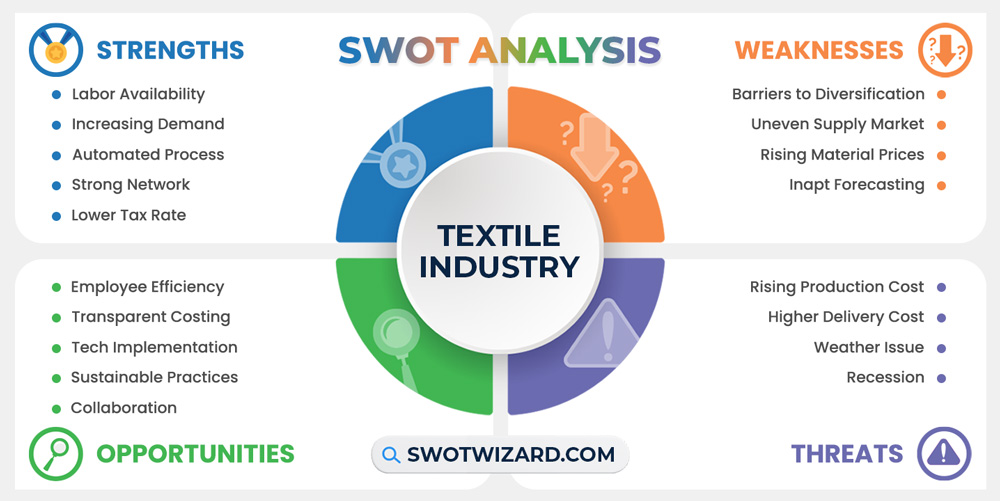
Recommendations for Textile Industry
The textile industry has become a part of our life, and it’s not going anywhere, but it must follow a few things to make the world better and more efficient.
- The priority should be sustainable production processes that minimize environmental impact, reduce waste, and develop green factories.
- Leveraging the latest digital technologies to streamline operations and optimize production processes will improve effectiveness and efficiency.
- Collaboration among the stakeholder and better employee training will help develop the skills and knowledge necessary to grow.
- The industry should engage with various stakeholders, including customers, governments, and industry leaders, to build trust and foster a more sustainable and socially responsible industry.
Frequently Asked Questions (FAQs)
Where Does Bangladesh Rank in Garments in the World?
Bangladesh ranks second in garments in the World, with a $39 B market in 2022.
What are the 3 Categories of the Textile Industry?
The three categories of the textile industry are Yarn & Fabric manufacturing, Garment manufacturing, and Technical textile.
Final Words on Textile Industry SWOT Analysis
The textile industry has been one of the significant contributors to global economic growth and employed millions of workers. The industry has experienced ups and downs, including globalization, economic recessions, weather issues, barriers to diversification, and many others. On the other hand, however, the industry has demonstrated resilience and adaptability, leveraging new technologies and sustainable practices to drive innovation and growth and also ensuring that the sector remains competitive and sustainable for years.
References
- Fleck, A. (2022, December 1). The Low Wages of Garment Workers. Statista.
- Demand in textile and apparel industry to pick up soon. (2022, July 14). Apparel Resources.
- Sudalaimuthu, S., & Vadivu, N. (2007, September). Technology and its impacts on textile industry. Fibre2Fashion.
- Germany – Corporate – Taxes on corporate income. (n.d.). PWC.
- Sabanoglu, T. (2022, December 5). Leading 10 textile importers worldwide 2021, by country. Statista.
- Russell, M. (2022, August 4). Textile raw material prices continue to increase. Just Style.
- Seçkin, M., Seçkin, A. Ç., & Coskun, A. (2019). Production fault simulation and forecasting from time series data with machine learning in glove textile industry. Journal of Engineered Fibers and Fabrics, 14, 155892501988346.
- Rahman, S. (2021, July 1). Confronting the challenges of unskilled workforce in RMG. The Daily Star.
- Wu, H. J., Su, J., & Hodges, N. (2019). Investigating the Role of Open Costing in the Buyer-Supplier Relationship: Implications for Global Apparel Supply Chain Management. Clothing and Textiles Research Journal, 41(2), 154–169.
- Technological Advances in the Textile Industry. (n.d.). Study.com.
- The impact of textile production and waste on the environment (infographic). (2020, December 29). European Parliament.
- Uddin, M. (2021, July 12). Collaboration is essential to solve the apparel industry’s challenges. The Daily Star.
- Jacob, S. (2022, June 19). Raw material price hike pinch Indias textiles, apparel exports in 2022-23. Business Standard.
- Tagra, B. D. (2023, February 2). Deep dive into the budget from the textile and apparel industry’s perspective. Apparel Resources.
- Mehta, M. (2013, May 13). How Does the Global Economic Crisis Affect Textile, Apparel Sourcing? RIS News.

